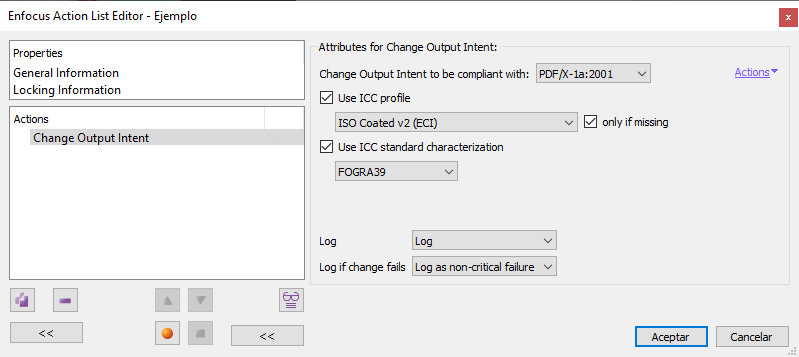
This Enfocus PitStop command allows us to change the output intent in a PDF (a structure which is used in some PDF standards, such as PDF/X and PDF/A). If the output intent does not exist, it is added.
The command has three parameters. The first one is mandatory and is always executed. The other two are optional.
"
Change output intent to compatible with": PDF standards and their different levels may have different nuances in the way the output intent is specified. In this section we can choose which of the available ones we want to set.In this version of PitStop, there are 6 PDF/X types available (PDF/X-1a:2001, PDF/X-1a:2003, PDF/X-3:2002, PDF/X-3:2003, PDF/X-4 and "
Any PDF/X version"), and two PDF/A types (PDF/A-1 and PDF/X-2). Choosing any of these does not convert the document to that standard, it just adds one of the steps needed to do so.Warning: It is not possible to choose "
None" to change only the next two options (profile and characterisation), so we must be clear which level of a PDF standard we want for the processed document."
Use ICC profile": This option allows you to designate an existing ICC profile in the system for printing purposes. The chosen profile does not have to be installed on the system, we can specify any unit within its reach by means of the "Examine..." command.If we check the option "Only if missing", the specified colour profile will only be applied if there is no profile, which is what will happen if there was no previous printing purpose and this is the first time it is applied.
"
Use standard ICC characterisation": This option allows you to choose one of the characterisations from the ICC standardised printing conditions.Warning: PitStop does not check that we choose a characterisation that matches the chosen colour profile, so if we are not sure that the match is correct we can make a mistake. If we have the colour profile (mandatory to make a PDF/X) but we do not know what the corresponding characterisation is (or it does not exist), it is better to leave this option unchecked.
[© Gustavo Sánchez Muñoz, 2025] Gustavo Sánchez Muñoz (also identified as Gusgsm) is the author of the content of this page. Its graphic and written content can be shared, copied and redistributed in whole or in part without the express permission of its author with the only condition that it cannot be used for directly commercial purposes (that is: It cannot be resold, but it can form part as reasonable quotations in commercial works) and the legal terms of any derivative works must be the same as those expressed in this statement. The citation of the source with reference to this site and its author is not mandatory, although it is always appreciated.